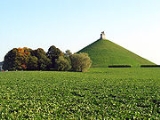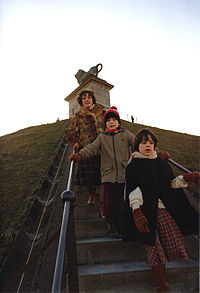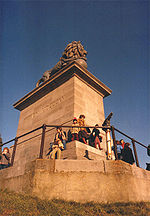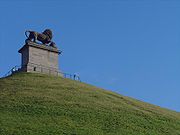
Butte du Lion
Encyclopedia
The Lion's Mound is a large conical artificial hill raised on the battlefield of Waterloo
to commemorate the location where William II of the Netherlands
(the Prince of Orange
) was knocked from his horse by a musket ball to the shoulder during the battle. It was ordered constructed in 1820 by his father, King William I
of The Netherlands, and completed in 1826. The younger William had fought at the Battle of Quatre Bras
(June 16) and the Battle of Waterloo
(June 18).
of the Belgae
, whom Julius Caesar
had singled out as the bravest of the Gallic
tribes.

 A huge mound was constructed at the spot, using earth taken from other parts of the battlefield, including the fields between La Haye Sainte
A huge mound was constructed at the spot, using earth taken from other parts of the battlefield, including the fields between La Haye Sainte
farm and the Duke of Wellington
's sunken lane.
The mound is 43 m (141 ft) in height and has a circumference of 520 m (1706 ft), which dimensions would yield a volume in excess of 390,000 m³ (514,000 yd³), despite the usual claim of 300,000 m³. The discrepancy might be accounted for if part of the volume is occupied by an existing volume of some topographic feature, say, the ridge of Mont-St. Jean.
Victor Hugo
mentions in his novel Les Miserables
that on visiting the site two years after the completion of the mound, the Duke of Wellington is said to have remarked, "They have altered my field of battle!" Be that as it may, the hillock offers a splendid vista of the battlefield, and is the anchor point of the tourist trade associated with it in le Hameau du Lion (Lion's Hamlet), where there are museums and taverns. A fee of 6 euro is charged to ascend the 226 steps leading to the statue and observation area at the top. Orientation maps documenting the battle and telescopes are provided.
 The hill is surmounted by a statue of a lion mounted upon a stone-block pedestal. The model lion was sculpted by Jean-François Van Geel (1756-1830). The lion
The hill is surmounted by a statue of a lion mounted upon a stone-block pedestal. The model lion was sculpted by Jean-François Van Geel (1756-1830). The lion
is the heraldic beast on the personal coat of arms
of the monarch of The Netherlands, and symbolizes courage; its right front paw is upon a sphere, signifying global victory. The statue weighs 28 tonnes (31 tons), has a height of 4.45 m (14.6 ft) and a length of 4.5 m (14.8 ft). It was cast at the iron foundry of William Cockerill
in Liège
, whence it was brought by canal barge from Liège to Brussels
, and thence by heavy horse-drays to its final site at Mont-St. Jean, a low ridge south of Waterloo.
There is a legend to the effect that the lion was cast from brass melted down from cannons abandoned by the French on the battlefield. The statue was, in fact, cast of iron in nine pieces, which were assembled at the monument site.
Battle of Waterloo
The Battle of Waterloo was fought on Sunday 18 June 1815 near Waterloo in present-day Belgium, then part of the United Kingdom of the Netherlands...
to commemorate the location where William II of the Netherlands
William II of the Netherlands
William II was King of the Netherlands, Grand Duke of Luxembourg, and Duke of Limburg from 7 October 1840 until his death in 1849.- Early life and education :...
(the Prince of Orange
Prince of Orange
Prince of Orange is a title of nobility, originally associated with the Principality of Orange, in what is now southern France. In French it is la Principauté d'Orange....
) was knocked from his horse by a musket ball to the shoulder during the battle. It was ordered constructed in 1820 by his father, King William I
William I of the Netherlands
William I Frederick, born Willem Frederik Prins van Oranje-Nassau , was a Prince of Orange and the first King of the Netherlands and Grand Duke of Luxembourg....
of The Netherlands, and completed in 1826. The younger William had fought at the Battle of Quatre Bras
Battle of Quatre Bras
The Battle of Quatre Bras, between Wellington's Anglo-Dutch army and the left wing of the Armée du Nord under Marshal Michel Ney, was fought near the strategic crossroads of Quatre Bras on 16 June 1815.- Prelude :...
(June 16) and the Battle of Waterloo
Battle of Waterloo
The Battle of Waterloo was fought on Sunday 18 June 1815 near Waterloo in present-day Belgium, then part of the United Kingdom of the Netherlands...
(June 18).
The design
The monument was designed by the Royal Architect, Charles Van der Straeten, at the behest of William I. Inspiration was provided by the engineer Jean-Baptiste Vifquain, who conceived of it as a symbol of the Allied victory, rather than as pertaining to a single individual. The shape consciously recapitulates that of the tumulusTumulus
A tumulus is a mound of earth and stones raised over a grave or graves. Tumuli are also known as barrows, burial mounds, Hügelgrab or kurgans, and can be found throughout much of the world. A tumulus composed largely or entirely of stones is usually referred to as a cairn...
of the Belgae
Belgae
The Belgae were a group of tribes living in northern Gaul, on the west bank of the Rhine, in the 3rd century BC, and later also in Britain, and possibly even Ireland...
, whom Julius Caesar
Julius Caesar
Gaius Julius Caesar was a Roman general and statesman and a distinguished writer of Latin prose. He played a critical role in the gradual transformation of the Roman Republic into the Roman Empire....
had singled out as the bravest of the Gallic
Gauls
The Gauls were a Celtic people living in Gaul, the region roughly corresponding to what is now France, Belgium, Switzerland and Northern Italy, from the Iron Age through the Roman period. They mostly spoke the Continental Celtic language called Gaulish....
tribes.
The hill


La Haye Sainte
La Haye Sainte is a walled farmhouse compound at the foot of an escarpment on the Charleroi-Brussels road. It has changed very little since it played a very important part in the battle of Waterloo on June 18, 1815...
farm and the Duke of Wellington
Arthur Wellesley, 1st Duke of Wellington
Field Marshal Arthur Wellesley, 1st Duke of Wellington, KG, GCB, GCH, PC, FRS , was an Irish-born British soldier and statesman, and one of the leading military and political figures of the 19th century...
's sunken lane.
The mound is 43 m (141 ft) in height and has a circumference of 520 m (1706 ft), which dimensions would yield a volume in excess of 390,000 m³ (514,000 yd³), despite the usual claim of 300,000 m³. The discrepancy might be accounted for if part of the volume is occupied by an existing volume of some topographic feature, say, the ridge of Mont-St. Jean.
Victor Hugo
Victor Hugo
Victor-Marie Hugo was a Frenchpoet, playwright, novelist, essayist, visual artist, statesman, human rights activist and exponent of the Romantic movement in France....
mentions in his novel Les Miserables
Les Misérables
Les Misérables , translated variously from the French as The Miserable Ones, The Wretched, The Poor Ones, The Wretched Poor, or The Victims), is an 1862 French novel by author Victor Hugo and is widely considered one of the greatest novels of the nineteenth century...
that on visiting the site two years after the completion of the mound, the Duke of Wellington is said to have remarked, "They have altered my field of battle!" Be that as it may, the hillock offers a splendid vista of the battlefield, and is the anchor point of the tourist trade associated with it in le Hameau du Lion (Lion's Hamlet), where there are museums and taverns. A fee of 6 euro is charged to ascend the 226 steps leading to the statue and observation area at the top. Orientation maps documenting the battle and telescopes are provided.
The statue

Lion (heraldry)
The lion is a common charge in heraldry. It traditionally symbolises bravery, valour, strength, and royalty, since traditionally, it is regarded as the king of beasts.-Attitudes:...
is the heraldic beast on the personal coat of arms
Coat of arms of the Netherlands
The Greater Coat of Arms of the Realm, , is the personal coat of arms of the monarch of the Netherlands . The government of the Netherlands uses a smaller version without the mantle or the pavilion or sometimes even only uses the shield and crown...
of the monarch of The Netherlands, and symbolizes courage; its right front paw is upon a sphere, signifying global victory. The statue weighs 28 tonnes (31 tons), has a height of 4.45 m (14.6 ft) and a length of 4.5 m (14.8 ft). It was cast at the iron foundry of William Cockerill
William Cockerill
William Cockerill was a British entrepreneur who created a textile machine manufacturing business in Verviers and Liege, Belgium ....
in Liège
Liège
Liège is a major city and municipality of Belgium located in the province of Liège, of which it is the economic capital, in Wallonia, the French-speaking region of Belgium....
, whence it was brought by canal barge from Liège to Brussels
Brussels
Brussels , officially the Brussels Region or Brussels-Capital Region , is the capital of Belgium and the de facto capital of the European Union...
, and thence by heavy horse-drays to its final site at Mont-St. Jean, a low ridge south of Waterloo.
There is a legend to the effect that the lion was cast from brass melted down from cannons abandoned by the French on the battlefield. The statue was, in fact, cast of iron in nine pieces, which were assembled at the monument site.

